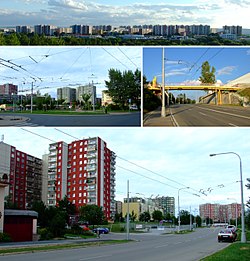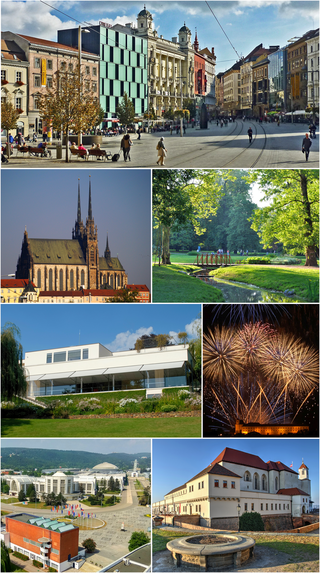
Brno is a city in the South Moravian Region of the Czech Republic. Located at the confluence of the Svitava and Svratka rivers, Brno has about 400,000 inhabitants, making it the second-largest city in the Czech Republic after the capital, Prague, and one of the 100 largest cities of the European Union. The Brno metropolitan area has approximately 720,000 inhabitants.

Újezd u Brna is a town in Brno-Country District in the South Moravian Region of the Czech Republic. It has about 3,400 inhabitants.

Slavkov u Brna is a town in Vyškov District in the South Moravian Region of the Czech Republic. It has about 7,200 inhabitants. The town gave its name to the Battle of Austerlitz, which took place several kilometres west of the town. The historic town centre is well preserved and is protected by law as an urban monument zone.
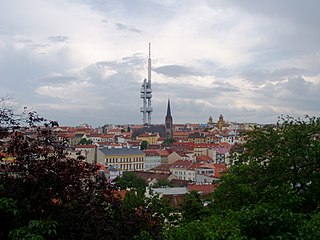
Žižkov is a cadastral district of Prague, Czech Republic.

Hustopeče is a town in Břeclav District in the South Moravian Region of the Czech Republic. It has about 6,400 inhabitants. It is known for fruit and wine growing.
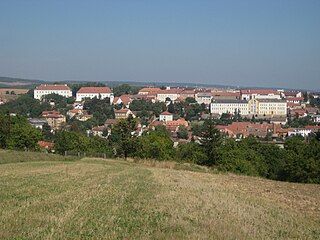
Rosice is a town in Brno-Country District in the South Moravian Region of the Czech Republic. It has about 6,700 inhabitants.

Těšany is a municipality and village in Brno-Country District in the South Moravian Region of the Czech Republic. It has about 1,300 inhabitants.
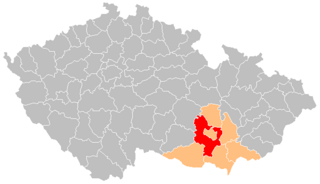
Brno-Country District is a district in the South Moravian Region of the Czech Republic. Its capital is the city of Brno. The most populated town of the district is Kuřim. The district is made up of 187 municipalities, which is the highest number within all districts of the Czech Republic.
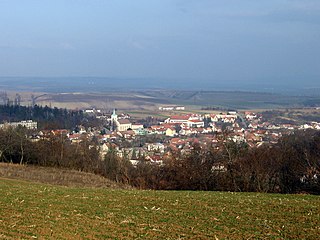
Klobouky u Brna is a town in Břeclav District in the South Moravian Region of the Czech Republic. It has about 2,500 inhabitants.

Olešnice is a town in Blansko District in the South Moravian Region in the Czech Republic. It has about 1,600 inhabitants.

Hrušovany u Brna is a municipality and village in Brno-Country District in the South Moravian Region of the Czech Republic. It has about 3,600 inhabitants.

Ochoz u Brna is a municipality and village in Brno-Country District in the South Moravian Region of the Czech Republic. It has about 1,600 inhabitants.
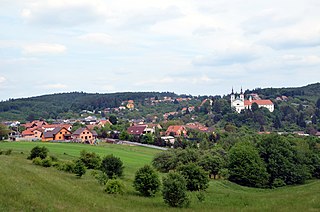
Vranov is a municipality and village in Brno-Country District in the South Moravian Region of the Czech Republic. It has about 900 inhabitants.

Zastávka is a municipality and village in Brno-Country District in the South Moravian Region of the Czech Republic. It has about 2,500 inhabitants.

Kobeřice u Brna is a municipality and village in Vyškov District in the South Moravian Region of the Czech Republic. It has about 700 inhabitants.

Královo Pole is a city district of Brno, the second largest city in the Czech Republic. It is made up of the cadastral territories of Královo Pole, Ponava and Sadová, as well as the northwestern corner of Černá Pole. The municipal district was established on November 24, 1990. It has about 30,000 inhabitants.

Brno-Jehnice is a city district of Brno in the Czech Republic. Originally, it was an independent village called Jehnice. It became a part of Brno in 1971. Its cadastral territory has an area of 4.07 km² and 1,090 people live here as of 2021.

Vladimír Fischer was a Czech architect, professor and university administrator. He was a major figure in the development of modern architecture in the new state of Czechoslovakia after World War I and trained numerous university architecture students in Brno during the interwar period.

Brno-Komín is a city district in Brno, Czech Republic, in the northwestern part of the city. It consists of the cadastral territory of Komín, originally an independent municipality that was annexed to Brno in 1919. Its cadastral territory has an area of 7.60 km2. The municipal district was established on November 24, 1990. About 8,000 inhabitants live here.

Brno-Líšeň is a city district of Brno, Czech Republic, in the northeastern part of the city. It consists of the cadastral territory of Líšeň, originally a town that was annexed to Brno in 1944. The cadastral territory has an area of 15.71 km2. The city district was established on November 24, 1990. Over 26,000 people live here.
